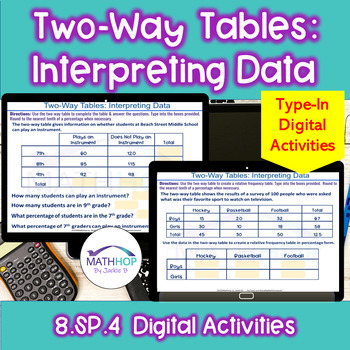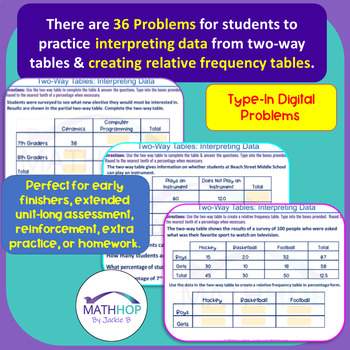Two-Way Tables & Relative Frequency Tables: Interpreting Data - Digital Activity
- Google Drive™ folder

What educators are saying
Description
Need engaging practice for students to practice interpreting data from two-way tables & relative frequency tables and creating relative frequency tables? This collection of NO PREP Digital problems provide practice on creating & interpreting two-way tables & relative frequency tables in percentage form. Students struggle with data in two-way tables but practice CAN BE engaging. These digital activities that can be used as homework, assessments, supplemental activities.
⭐ 12 total slides with 36 total problems
⭐ Answer Key Included
⭐ Can be done in class or given as a remote learning homework assignment. Perfect for
students needing additional practice.
Follow Me! to be notified about my products, sales, updates, and FREEBIES!
Connect with Me!
Use Hundreds of my Math Videos in Your Class!
Check out my custom course materials:
I WOULD LOVE YOUR FEEDBACK!
Remember to leave feedback and you will earn points toward FREE TPT purchases. I love your feedback!
LICENSING TERMS: This purchase includes a license for one teacher only for personal use in their classroom. Licenses are non-transferable, meaning they cannot be passed from one teacher to another. No part of this resource is to be shared with colleagues or used by an entire grade level, school, or district without purchasing the proper number of licenses. If you are a coach, principal, or district interested in transferable licenses to accommodate yearly staff changes, please contact me for a quote at MathHop321@gmail.com.
COPYRIGHT TERMS: This resource may not be uploaded to the internet in any form, including classroom/personal websites or network drives, unless the site is password protected and can only be accessed by students.
Products by MathHop by Jackie B, LLC may be used by the purchaser for their classroom use only. Use on Outschool is strictly prohibited. This is a single classroom license only. All rights reserved. Resources may only be posted online in an LMS such as Google Classroom, Canvas, or Schoology. Students should be the only ones able to access the resources. It is a copyright violation to upload the files to school/district servers or shared Google Drives.



